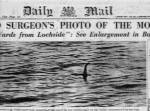The "Surgeon's Photograph", the most famous photo allegedly showing the Loch Ness Monster, is published in the Daily Mail (in 1999, it is revealed to be a hoax).
The "Surgeon's Photograph"
The "Surgeon's Photograph" purported to be the first photo of a "head and neck". Dr. Wilson claimed he was looking at the loch when he saw the monster, so grabbed his camera and snapped five photos. After the film was developed, only two exposures were clear. The first photo (the more publicised one) shows what was claimed to be a small head and back. The second one, a blurry image, attracted little publicity because it was difficult to interpret what was depicted. The image was revealed as a fake in The Sunday Telegraph dated 7 December 1975. Supposedly taken by Robert Kenneth Wilson, a London gynaecologist, it was published in the Daily Mail on 21 April 1934. Wilson's refusal to have his name associated with the photograph led to it being called "Surgeon's Photograph". The strangely small ripples on the photo fit the size and circular pattern of small ripples as opposed to large waves when photographed up close. Analysis of the original uncropped image fostered further doubt. In 1993, the makers of Discovery Communications's documentary Loch Ness Discovered analysed the uncropped image and found a white object was visible in every version of the photo, implying it was on the negative. It was believed to be the cause of the ripples, as if the object was being towed, though it could not be ruled out as a blemish in the negative. Additionally, one analysis of the full photograph revealed the object was quite small, only about 60 to 90 cm (2 to 3 ft) long. However, analyses of the size of the photograph have been inconsistent.
In 1979 it was claimed to be a picture of an elephant (see below). Other sceptics in the 1980s argued the photo was that of an otter or a diving bird, but after Christian Spurling's confession most agree it was what Spurling claimed – a toy submarine with a sculpted head attached. Details of how the photo was accomplished were published in the 1999 book, Nessie – the Surgeon's Photograph Exposed, that contains a facsimile of the 1975 article in The Sunday Telegraph. Essentially, it was a toy submarine bought from F.W. Woolworths with a head and neck made of plastic wood, built by Christian Spurling, the son-in-law of Marmaduke Wetherell, a big game hunter who had been publicly ridiculed in the Daily Mail, the newspaper that employed him. Spurling claimed that to get revenge, Marmaduke Wetherell committed the hoax, with the help of Chris Spurling (a sculpture specialist), his son Ian Marmaduke, who bought the material for the fake, and Maurice Chambers (an insurance agent), who asked surgeon Robert Kenneth Wilson to offer the pictures to the Daily Mail. The hoax story is disputed by Henry Bauer, who claims this debunking is evidence of bias, and asks why the perpetrators did not reveal their plot earlier to embarrass the newspaper. He also claimed that plastic wood did not exist in 1934 (when actually it was a popular DIY and modelling material in the early 1930s).
Tim Dinsdale also disputes the claim of this photograph as a hoax in his book Loch Ness Monster. He claims that he studied the photograph so often and from many different angles that he was able to discern objects that prove the photograph is not a hoax. He states "upon really close examination, there are certain rather obscure features in the picture which have a profound significance." Two of the obscure features are: a solid object breaking the surface to the right of the neck, and to the left and behind the neck there is another mark of some sort, Dinsdale states. After making this claim Dinsdale discusses that these objects are too hard to identify, but that just proves that they could be part of the monster. According to Dinsdale either the objects are part of a very subtle fake or genuinely part of the monster. Another object that he points out to prove the photograph is not a fake is the vague smaller ripples that are behind the neck, which seem to have been caused after the neck broke the surface. Dinsdale emphatically states that this is a part of the animal underwater behind the neck. His reasons suggest that it is possible that the photograph is not a fake.
Alastair Boyd, one of the researchers who uncovered the hoax, argues that the Loch Ness Monster is real, and that although the famous photo was hoaxed, that does not mean that all the photos, eyewitness reports, and footage of the monster were as well. He asserts that he too had a sighting and also argues that the hoaxed photo is not a good reason to dismiss eyewitness reports and other evidence.
(for the picture wsite pub.ne.jp)


























